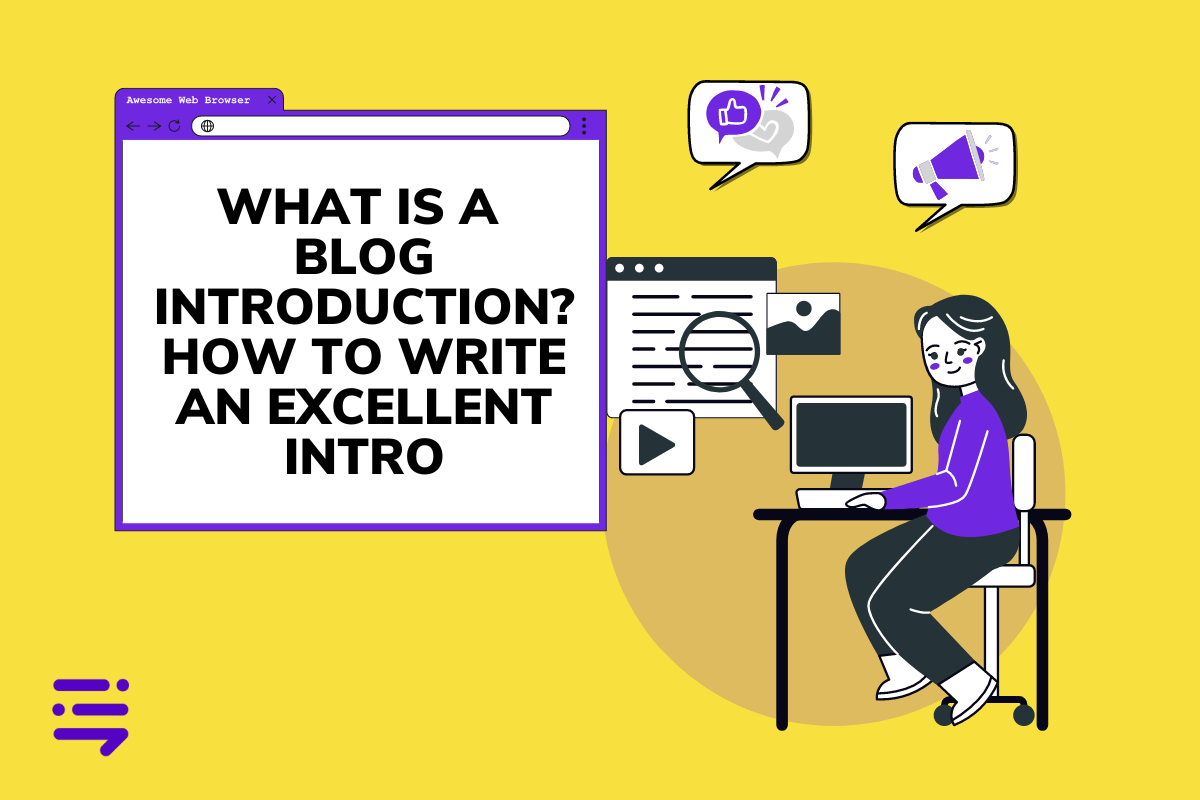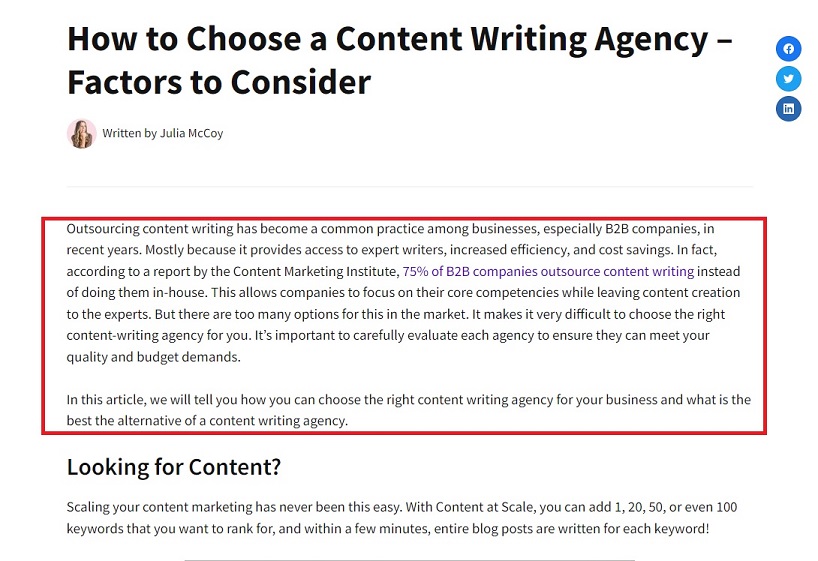Discover top guides, trends, tips and expertise from AIO Writers
What Is a Blog Introduction? How to Write an Excellent Intro
Julia McCoy
Wednesday, 31st Jul 2024
What is a blog introduction and why is it important?
Let’s put it this way:
There are 4,800 blog posts that go live every minute, and many of them are in your niche competing for the same audience as yours. How do you stand out and get those readers hooked?
You need a catchy, benefit-oriented, and compelling introduction.
Blog post introductions are important because they can make or break your blog post — it’s the difference between readers scrolling down or moving on.
In this ultimate guide on how to write an opening paragraph for your blog, you will learn:
- What is a blog introduction
- What elements go into a good blog introduction
- How to write a compelling introduction
Let’s dive in so you can start writing blog introductions that engage readers.
Table of Contents
Elements of an Effective Blog Introduction
The Ideal Length for Blog Introductions
Techniques For Writing Engaging Blog Intros
Best Practices for Writing a Good Blog Introduction
What is a Blog Introduction?
A blog introduction is the first paragraph of your blog post. It typically appears right below the title and is the first section that readers see when they visit a blog (without the need to scroll down).
Blog post introductions are your first chance to impress readers and set the tone for what’s to come. A good blog introduction can spark their interest so it’s important to write something compelling that will capture their attention right away.

Introductions are essential for both reader engagement and improving a post’s ranking on search engine results pages (SERPs).
By including relevant keywords throughout your introduction—as well as other sections of your post — you increase its chances of appearing higher up in SERPs. This will give you more visibility online and ultimately result in increased traffic on both social media platforms and websites where it is posted.
The importance of a blog introduction cannot be overstated. It is the first impression readers have and can determine whether they continue to read or not. Therefore, understanding how to craft an effective blog intro is essential for success in content marketing.
How to write a great blog post introduction:
Plant a question in the reader’s mind.
Don’t answer it until the end.
— Tom Kuegler (@tomkuegler7) March 21, 2022
Elements of an Effective Blog Introduction
When you’re writing a blog introduction, your main goal is to draw in readers and keep them engaged. Here are some elements that can help you craft a compelling intro.
1. Build Anticipation with Mystery or Intrigue
An intriguing opening line will get your reader’s attention right away. You can use mystery or suspense by hinting at something without giving too much away or posing a thought-provoking question that encourages people to keep reading to find the answer.
2. Highlight Pain Points
A great way to connect with readers is by highlighting a problem they may have encountered before and showing how you plan on solving it through your post. This shows empathy for your audience as well as demonstrates your expertise in the topic area – both of which increase engagement levels.
3. Add Statistics
Numbers speak louder than words, so using statistics in your introduction can be incredibly powerful when trying to draw people in. They give context and provide proof that what you’re saying is true. Not to mention, they make things easier for readers who don’t want to read long paragraphs of text.
4. Empathize With Your Audience
Connecting with your reader on an emotional level can increase engagement rates significantly.
Why? Because it makes them feel seen and heard by someone who understands their struggles or experiences. Showing empathy through storytelling tactics such as anecdotes or metaphors helps build trust between your brand and your potential customers – increasing conversion rates overall.
5. Provide Value
Your opening paragraph should introduce something valuable that readers won’t find anywhere else. This could be advice, tips and tricks, or case studies — whatever resonates most with your target audience. Promising this upfront gives readers a reason to invest time reading the rest of your article.
An effective blog introduction should engage the reader, provide context and direction for the content to follow, and set up a strong foundation for success.
So how long should a blog introduction be?
The Ideal Length for Blog Introductions
When it comes to crafting an effective blog introduction, length is one of the most important factors.
The ideal word count will depend on the type of topic and target audience preferences.
For example, a technical post may require more words than a lighthearted piece about lifestyle topics. Additionally, consider mobile optimization when deciding how long an intro should be, as users are often accessing content from their phones or tablets.
For general-purpose blog posts, 100-200 words are usually sufficient for intros. Reviews or opinion pieces can also have shorter intros that focus primarily on providing background information without delving too deeply into details.
On the other hand, technical topics such as coding tutorials or financial advice may require longer paragraphs to properly introduce concepts and provide context for readers unfamiliar with them.
When determining word count for blog intros, user behavior also plays a role in engagement rates. People tend to skim through content before committing to reading all of it so having shorter paragraphs and bullet points can help break up text blocks to keep readers engaged.
Now let’s explore some writing techniques for crafting engaging intros.
Techniques For Writing Engaging Blog Intros
The opening paragraph of any piece of writing should be interesting enough to draw people in and keep them engaged until the end. An effective way to do this is by introducing a controversial topic, opinion, or story at the beginning that captures readers’ curiosity and encourages them to read on.
- Catchy phrases or witty one-liners are great for your opening line as these can grab people’s attention from the start.
- Humor and allusions to popular culture can add variety to an introduction, as well as provide readers with a relatable context.
- Making jokes or referencing popular movies, TV shows, or books also helps draw people in and keep them interested.
- Storytelling tactics like anecdotes or metaphors also capture the reader’s attention as they set the tone for the post.
- Anecdotes allow you to connect with your audience on a personal level by sharing experiences from your own life.
- Metaphors paint a vivid image of what you’re discussing in the post.
Using controversial opening statements also can be effective when introducing topics such as politics or religion. This tactic grabs people’s attention right away and gets them thinking about different perspectives before diving into the main points. This technique should only be used sparingly and carefully since it could potentially alienate some readers.
Your writing style is also important when creating engaging intros. Remember the acronym KISS: keep it short and sweet. Sentences with less than 25 words are easier to read while long sentences can make people skip ahead or exit the page entirely.
Including relevant keywords in your intro will help search engines index your content so that potential readers can find it more easily – this is especially useful for SEO purposes.
Finally, writing with an authoritative yet conversational style helps establish trust between you and your readers while also making your content more relatable.
Let’s look at some of the best practices for writing engaging intros that use humor, storytelling, and anecdotes to break the monotony of long-form content.

Screenshot from Neil Patel’s Ultimate Guide to Writing Blog Post Introductions
Best Practices for Writing a Good Blog Introduction
1. Highlight a Common Problem
Highlighting a common problem in your introduction is an effective way to grab the reader’s attention. It shows them that you understand their issue and are offering a solution.
For example, if you’re writing about ways to increase website traffic, start by talking about how frustrating it can be when all of your efforts don’t seem to make any difference. Showing empathy towards the reader will make them more likely to read on and find out what solutions you have for them.
2. Ask a Question
Questions can be a powerful tool in blog intro writing. Questions can help engage readers, encourage them to think about the topic more deeply, and even generate leads.
3. Take a Stand
Taking a stand helps create tension and engagement with your audience, especially if the topic is controversial. By challenging long-held beliefs or ideas in your niche, you demonstrate that you are knowledgeable about the topic and willing to take risks to get noticed. This type of attitude can draw the attention of both new and existing audiences.
4. Use a Quote
Quotes can be a great way to lend credibility and create a compelling intro. Consider using quotes from unexpected voices or source original quotes from thought leaders. This can help back up your claims and provide a framework to structure the rest of your content.
However, it’s important not to overuse this tactic as it can become a crutch for lazy writing. Instead, use quotes sparingly to make the most impact with them.
It is also wise to avoid quotations that are overused in your niche — for example, “content is king” in marketing — as these have been used too many times before and will fail to capture readers’ attention. To really stand out, think outside the box and don’t limit yourself to just those people within your industry who you already know about.
5. Avoid Filler Content
Don’t add extra words or phrases just for the sake of making your intro longer – keep it concise and focused on delivering value to the reader right away.
Learn how to cut the fluff in this comprehensive guide.
6. Be Direct and Interesting
Make sure your introduction is direct and interesting so that readers will want to read more after your first few lines. If you can make a joke, use a metaphor, or ask a thought-provoking question in your intro, do it.
7. Deliver What You Promise
When writing blog introductions, don’t promise something that isn’t included in the article. Otherwise, readers may feel cheated if they click through expecting one thing but not getting what was promised in the intro paragraph. https://youtu.be/D65BmHoNvl4
What is a Blog Introduction? One of the Most Vital Parts of a Blog
Blog introductions are a vital part of any post and should not be overlooked. Even if you’re generating content with a brand growth tool like BrandWell (which writes beautiful introductions), you must not rely 100% on a bot to craft your intros. An effective introduction will capture the attention of readers, draw them to your content, and set up expectations for what they can expect from reading further.
By using techniques such as storytelling, humor, and creating curiosity gaps, writers can create engaging intros that compel their audience to read more.
Now that you know what is a blog introduction and why it’s important, it’s time to get writing! Ultimately, great introductions come down to practice so take some time to study examples from successful bloggers before getting started with your own posts.

UNLOCK YOUR POTENTIAL
Long Headline that highlights Value Proposition of Lead Magnet
Grab a front row seat to our video masterclasses, interviews, case studies, tutorials, and guides.



